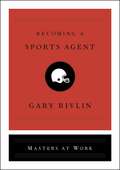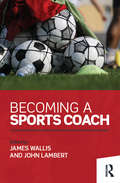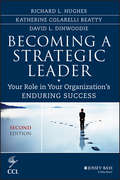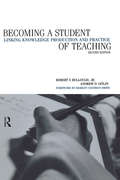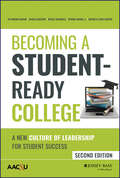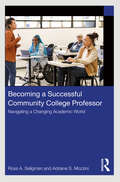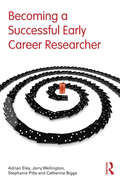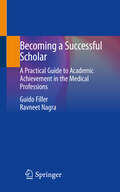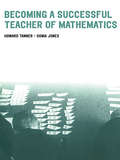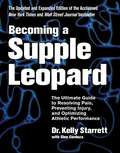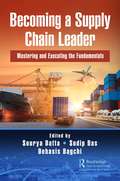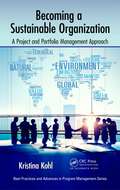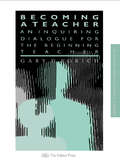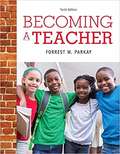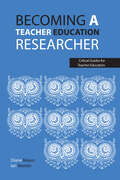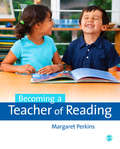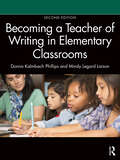- Table View
- List View
Becoming a Sports Agent (Masters at Work)
by Gary RivlinA revealing guide to a career as a sports agent written by Pulitzer Prize–winning journalist Gary Rivlin and based on the real-life experiences of several top agents—required reading for anyone considering this profession.Becoming a Sports Agent takes you behind the scenes to find out what it&’s really like, and what it really takes, to become a sports agent. Bestselling and Pulitzer Prize–winning reporter Gary Rivlin shadows some of the best agents in sports to show how this dream job becomes reality. Behind every high-profile athlete—in football, baseball, basketball, and more—is an agent. Learn the ins and outs of scouting, contract negotiation, licensing, brand building, and more. Takeaway invaluable lessons as you follow the paths of top-tier agents, from legendary pioneers like Leigh Steinberg, who represents star quarterback Patrick Mahomes, to Don Yee, who represents Tom Brady, to Matt Sosnick, whose client list includes baseball rookie sensation Pete Alonso. Rivlin uncovers the realities of this cut-throat business, from discovering unknown talent to securing multi-million-dollar deals.
Becoming a Sports Coach
by John Lambert James WallisA ‘coach’ is more than just somebody who leads in the organisation and delivery of structured sport. The role of a coach goes beyond leadership, requiring an understanding of theories of teaching and learning. To become a coach you must know how people learn. Becoming a Sports Coach aims to introduce the multi-dimensional and inter-locking knowledge bases that any aspiring coach will need to develop, and that any established coach needs to master in order to improve their professional practice. While traditional coach education pathways have focused on what to coach, this book argues that understanding how knowledge can be communicated to learners is just as important. Asking why we coach, through critical reflection and self-knowledge, is also an essential part of the process of becoming a sports coach. The book explores three types of knowledge – content knowledge, pedagogic knowledge and self-knowledge – challenging the reader to reflect on their own coaching experiences and to develop a personal philosophy of coaching. It explores key pedagogic themes in contemporary coaching studies, such as humanistic coaching, inclusive practice, coaching for understanding, and the athlete-coach relationship. Real case studies are used to illuminate the ways – transferrable across sports - in which coaches can apply theory to practice and ultimately enhance their work. With contributions from leading coaching researchers and practitioners, combining practical guidance with important theoretical insights, this book will help any coaching student or developing professional to better understand the journey to becoming an effective sports coach.
Becoming a Strategic Leader: Your Role in Your Organization's Enduring Success (J-B CCL (Center for Creative Leadership))
by Richard L. Hughes Katherine M. Beatty David DinwoodieIn the second edition of the best-selling Becoming a Strategic Leader, Richard L. Hughes, Katherine Colarelli Beatty, and David L. Dinwoodie draw from the Center for Creative Leadership's (CCL) acclaimed Leading Strategically program to offer executives and managers a comprehensive approach to strategic leadership that reaches leaders at all levels of organizations. This thoroughly revised edition concentrates on practical tools for producing impact right away. The authors place special emphasis on three essential strategic components: discovering and prioritizing strategic drivers, which determine sustainability and competitiveness; leadership strategy, which ignites the connections between people critical to enacting the business strategy; and how to foster the individual and organizational learning that is foundational to sustained performance. The authors and other leadership development professionals have used the distinctive and systematic approach described in this book with great success in CCL's Leading Strategically program. The second edition also contains improved self-assessments that help to align the book's lessons learned with the program's current practices. Readers will find fresh suggestions about developing the individual, team, and organizational skills needed for institutions to become more adaptable, flexible, and resilient. These are critical strategic attributes in a time of ever more rapid change, greater uncertainty, and globalization.
Becoming a Strategic Partner: Leverage HR Practices to Deliver Results
by Dave UlrichHR professionals acting as business partners play many roles, one of which is strategic partner, charged with turning strategy into action. When HR professionals work as strategic partners, they work with line managers to institute and manage a process that creates an organization to meet business requirements.
Becoming a Student of Teaching: Linking Knowledge Production and Practice (Critical Education Practice Ser. #Vol. 2)
by Andrew Gitlin Robert V. BulloughThis new edition of a very successful book offers an innovative teaching methodology that place the teacher's own biography and life experiences at the center of teacher education. By asking students to explore their own systems of meaning and the associated contexts, especially school contexts, the author encourages them to contemplate issues of power that are vital to thinking about the teacher's role, as well as educational practices and purposes.
Becoming a Student-Ready College: A New Culture of Leadership for Student Success
by Tia Brown McNair Susan Albertine Michelle Asha Cooper Nicole McDonald Thomas Major, Jr.Boost student success by reversing your perspective on college readiness The national conversation asking "Are students college-ready?" concentrates on numerous factors that are beyond higher education's control. Becoming a Student-Ready College flips the college readiness conversation to provide a new perspective on creating institutional value and facilitating student success. Instead of focusing on student preparedness for college (or lack thereof), this book asks the more pragmatic question of what are colleges and universities doing to prepare for the students who are entering their institutions? What must change in an institution's policies, practices, and culture in order to be student-ready? Clear and concise, this book is packed with insightful discussion and practical strategies for achieving your ambitious student success goals. These ideas for redesigning practices and policies provide more than food for thought—they offer a real-world framework for real institutional change. You'll learn: How educators can acknowledge their own biases and assumptions about underserved students in order to allow for change New ways to advance student learning and success How to develop and value student assets and social capital Strategies and approaches for creating a new student-focused culture of leadership at every level To truly become student-ready, educators must make difficult decisions, face the pressures of accountability, and address their preconceived notions about student success head-on. Becoming a Student-Ready College provides a reality check based on today's higher education environment.
Becoming a Student-Ready College: A New Culture of Leadership for Student Success
by Tia Brown McNair Susan Albertine Nicole McDonald Thomas Major Jr. Michelle Asha CooperReimagining the Culture of Leadership for Student Success A revision to the practical and popular guide, this book asks the crucial question within today's environment, "What's a student-ready college?" Higher education leaders are responsible for preparing their institutions to serve the students they admit in the best way possible. By asking ourselves how we can transform our institutions into student-ready colleges to create a new culture of leadership that is responsive to current challenges and focuses on understanding and utilizing student assets and social capital to achieve shared goals for student success. Becoming a Student-Ready College shows you how. Conversations in higher education tend to focus on defining college readiness for students. Too often, we forget to ask the question from the other side, and we miss important opportunities to develop institutions in ways that can help students thrive. Higher education leaders and educators can better serve today's college students through responsive and redesigned practices and policies. This updated edition features revisions and new material that speak to the social realities of today's incoming students and cover the latest strategies and techniques for connecting with learners to foster equity and success. Leverage existing resources to the benefit of students and deliver the right support at the right time to achieve equity in student outcomes and build on students' assets Design eco-systemic partnerships and support programs that nurture the relationship between the student and the institution Strengthen institutional capacity-building for achieving defined student-ready goals Build shared governance to promote agency and to foster change and collaboration Becoming a Student-Ready College explores leaders' shared responsibilities in advancing student success and provides practical recommendations for educators at all levels.
Becoming a Successful Community College Professor: Navigating a Changing Academic World
by Ross A. Seligman Adriane S. MozziniDesigned to mentor aspiring and current faculty, Becoming a Successful Community College Professor analyzes the ways in which the current institution of community colleges affects both staff and students, and presents strategies for effectively navigating the community college professor role from the point of job search to tenure status. With emphasis on key elements such as getting hired, class preparation, student needs, college policies and culture, and an abundance more, this book focuses on training professors to successfully overcome the challenges that the current academic climate presents. Through the inclusion of interview vignettes with faculty across the United States, this book represents a wide range of disciplines and closely examines socioeconomic classes, racial and ethnic identities, gender and sexuality, and the varying faculty positions within the community college. Coverage also consists of syllabi creation, assessment and grading, faculty mentoring, problem-solving in the classroom, and the nuances of online learning.Intended for graduate students and existing faculty, this book will provide insight into what community college professorship entails through discussions of equity and engagement, as well as offer valuable tips for keeping up with the field as it continually evolves.
Becoming a Successful Early Career Researcher
by Jerry Wellington Stephanie Pitts Adrian Eley Catherine BiggsNot that long ago there were fairly clear divisions between researchers at different stages throughout their career, starting with doctoral students then progressing to postdoctoral workers and finishing with academic staff. However, more recently the term Early Career Researcher (ECR) has been introduced partly as a response to their growing importance which has been reflected by their increased respect and status shown by national, international and funding bodies. There are several common features of an ECR’s job including the need to establish a professional identity and develop into an independent researcher, competing for grants and increasing one’s output of research publications; this book offers proven practical advice to help ECRs kick-start a successful academic career. With advice on: Choosing research topics Making best use of a Research Supervisor/Mentor Developing your research writing Getting published: journals and books Writing a research grant/fellowship Becoming a supervisor Becoming a teacher, and Developing your career This guide will help academics at the start of their career no matter what discipline they are engaged in… Arts, Humanities, Sciences or Social Sciences. For example, in sciences and engineering, ECRs are commonly part of a large research team and often have to work in collaborative groups; requiring strong interpersonal skills but can lead to tension in the interaction with one’s supervisor or mentor. In contrast, in the arts and humanities and perhaps the social sciences, an ECR is more likely to be an independent scholar with a requirement to work alone, leading to a different type of relationship (but not necessarily any less stressful) with one’s supervisor or mentor. Using case studies from across the subject areas to illustrate key points and give suitable examples this vital guide will help all early career academics.
Becoming a Successful Scholar: A Practical Guide to Academic Achievement in the Medical Professions
by Guido Filler Ravneet NagraThis book is a toolkit for young academic physicians and researchers to learn the behaviors and steps necessary for achieving success in academia. Written by a successful academic clinician, the book shares his personal experience alongside his years of successfully teaching and mentoring young medical professionals. The author’s main aim is to provide insightful tips and tricks that will hopefully not only motivate the reader to persevere through difficult competitive periods in his or her life, but also provide him or her with a strategic behavioral plan that will solidify his or her work habits and ensure success.This book begins with a chapter about why knowledge and learning should be communicated, and then expands on that mindset through both general behavioral changes and those specific to the life of an academic researcher, like writing articles. Some key topics covered in the text include:The importance of sharing knowledge and the associated public and personal benefitsTaking one step at a time and planning out work into small, attainable goalsDeveloping a growth mindsetThe importance of collaboration and successful mentors This is an ideal guide for young academic physicians and researchers working in universities, academic health sciences centers, and research institutes hoping to learn how to achieve success in academia. It could also prove useful to more established academics that need a refresher or a new perspective on their work and goals.
Becoming a Successful School Leader: Developing New Insights
by Krishan Sood Sheine Peart Malini MistryBecoming a Successful School Leader critically considers what leaders need to help them support their schools and communities with the challenges and demands of learning. It presents readers with opportunities to develop their thinking and to generate personal strategies to manage situations through a series of structured exercises and tasks. Drawing on a range of accounts from professionals, case studies and reflective questions, this accessible text allows leaders to confidently guide their staff and students through the contested landscape of education. Focusing on key topics, chapters cover: education policy and leadership, governance and management of educational settings; changes to the employment market; inclusion in education, emerging moral dilemmas and legislative changes; the structure of education: new frameworks and models; quality assurance: responsibilities, liabilities and consequences; global dimensions and emerging ethical issues. This book will be essential reading for both practising and aspiring school leaders who have an interest in the challenges, policies and practices deployed in leading and managing change in a variety of educational settings.
Becoming a Successful Scientist
by Craig LoehleLoehle (principal scientist, National Council for Air and Stream Improvement, Inc.) provides practical advice applicable for students and researchers in all scientific disciplines on how to be successful in their fields. A sampling of topics includes: strategic creativity and problem solving, analysis and solutions, conducting a research program, ethics, publishing, the practice of scientific discovery, and the myth of objective science advice. Annotation ©2010 Book News, Inc. , Portland, OR (booknews.com)
Becoming a Successful Teacher of Mathematics
by Howard Tanner Sonia JonesBecoming a Successful Teacher of Maths is a practical guide for newly qualified teachers of secondary mathematics. It develops the essential core knowledge, skills and understanding demanded by the new DfEE requirements for courses of initial teacher training. It is based on research findings relating to the organisation and management of maths classrooms, teaching approaches, assessment and the common misconceptions which often hinder pupils' progress in key areas of the National Curriculum. Theoretical principles are exemplified through case-study material. Suggestions for school-based activities are made. While being a practical 'how to' guide for beginning teachers, it also offers critical insights for more experienced teachers reflecting on their practice.
Becoming a Supple Leopard: The Ultimate Guide to Resolving Pain, Preventing Injury, and Optimizing Athletic Performance
by Kelly Starrett Glen CordozaImprove your athletic performance, extend your athletic career, treat stiffness and achy joints, and prevent and rehabilitate injuries—all without having to seek out a coach, doctor, chiropractor, physical therapist, or masseur. In Becoming a Supple Leopard, Dr. Kelly Starrett—founder of MobilityWOD.com—shares his revolutionary approach to mobility and maintenance of the human body and teaches you how to hack your own movement, allowing you to live a healthier, more fulfilling life. This new edition of the New York Times and Wall Street Journal bestseller has been thoroughly revised to make it even easier to put to use. <p><p> Want to truly understand the principles that guide human movement? Becoming a Supple Leopard lays out a blueprint for moving safely and effectively through life and sport. Want to learn how to apply those principles to specific movements, whether you are doing squats in the gym or picking up a bag of groceries? Hundreds of step-by-step photos show you not only how to perform a host of exercise movements, such the squat, deadlift, pushup, kettlebell swing, clean, snatch, and muscle-up, but also how to correct the common faults associated with those movements. Frustrated because you can’t perform a certain movement correctly due to range of motion restrictions? Breaking the body down into 14 distinct areas, Starrett demonstrates hundreds of mobilization techniques that will help you resolve restrictions and reclaim your mobility. Unsure how to put it all together into a program that addresses your individual needs? This updated edition lays out dozens of prescriptions that allow you to hone in on a specific limitation, a nagging injury, or an exercise fault that you just can’t seem to get right. It even offers a 14-day full-body mobility overhaul. <p> Performance is what drives us as human beings, but dysfunctional movement patterns can bring the human body to an abrupt halt. Often, the factors that impede performance are invisible even to seasoned athletes and coaches. Becoming a Supple Leopard makes the invisible visible. Whether you are a professional athlete, a weekend warrior, or simply someone wanting to live healthy and free from physical restrictions, this one-of-a-kind training manual will teach you how to harness your athletic potential and maintain your body.
Becoming a Supply Chain Leader: Mastering and Executing the Fundamentals
by Sourya DattaThe book explains how to emerge and grow as a supply chain leader and details supply chain and procurement processes and operational activities in real-work scenarios across multiple supply chain verticals. The book defines what an entry-level supply chain professional must do to excel in various types of supply chain verticals such as IT, electronics manufacturing, pharmaceutical, retail, and consumer goods. Apart from helping professionals understand vertical specific nuances, this book helps them to set both short-term goals for annual performance review and longer-term career planning. In addition, for a mid- or senior-level supply chain professional, the book offers ideas on ways to launch initiatives and demonstrate leadership to foster career growth. It offers ideas about unlocking new values for the organization and creating a data-driven decision support platform to gain financial efficiency for better management of CapEx and OpEx spend, thus improving the bottom line. The book includes a tool kit which includes operational data models, financial models, and presentation templates for creating and socializing proposals intended for cross-functional teams and demonstrating supply chain leadership. The book is divided into four major parts. In Part I, the book starts with an overview of key concepts in a manufacturing supply chain and procurement organization. It describes current forms of modern global supply chain and corporate procurement organizations. The objective of Part II is to provide a framework for a self-directed supply chain manager to understand how a large organization evaluates the contribution of supply chain managers and where it expects them to create value. To foster career growth as a supply chain professional, the book identifies six key knowledge pillars for demonstrating supply chain mastery: Technical and market knowledge of the end product and its constituents. Knowledge of internal product development and sustaining processes and supporting consumption data. Health and market condition of the supplier. Ability to create value. Ability to build internal and external executive relationships with key influencers. Ability to obtain best cost without compromising on quality and lead time. Negotiating cost, sourcing material, and then the logistics of moving the raw material through multiple stages and finally finished materials across the globe are some of the key areas which need continuous improvement. As a sentinel of efficiency, removing any kind of wastage leads to immediate value creation and contributes to the margin by improving the bottom line. In Part III, the book reviews twelve such verticals namely printer, medical, IT, energy, automotive, cloud, dairy, data management, avionics, biotech, apparel and start up and the supply chain nuances through the lenses of the framework created in Part II. In Part IV, the book goes back to focus on the professional growth of an individual supply chain person in an industry agnostic way. It provides examples of financial and operational efficiencies that a supply chain professional can create.
Becoming a Sustainable Organization: A Project and Portfolio Management Approach (Best Practices in Portfolio, Program, and Project Management)
by Kristina KohlOrganizations find that a performance gap exists between sustainability vision and benefits realization. Effecting transformational change requires incorporating sustainability into organization's culture including policies, processes, and people. Although they are often overlooked, project management professionals and HR professionals are valuable
Becoming a Teacher (Masters at Work)
by Melinda D. AndersonAn illuminating guide to a career as a teacher written by acclaimed journalist Melinda D. Anderson and based on the real-life experiences of a master teacher—essential reading for anyone considering a path to this profession that changes lives.Go behind the scenes and be mentored by the best in the business to find out what it&’s really like, and what it really takes, to become a teacher. Educators are the bedrock of a healthy society, and the exceptional ones have a lasting impact. The best teachers surpass mere instruction to cultivate and empower students beyond school. In LaQuisha Hall&’s classroom, students are &“scholars,&” young ladies are &“queens,&” and young men are &“kings.&” The Baltimore high school English teacher&’s pioneering approach to literacy has earned her teacher of the year accolades, and has established her as a visionary mentor to the young black men and women of Baltimore. Acclaimed education writer Melinda D. Anderson shadows Mrs. Hall to reveal how this rewarding profession changes lives. Learn about Hall&’s path to prominence, from the challenging realities of her rookie year to her place of excellence in the classroom. Learn from Hall&’s inspiring approach and confront the critical issues of race, identity, and equity in education. Here is how the job is performed at the highest level.
Becoming a Teacher: An Inquiring Dialogue For The Beginning Teacher (Teachers' Library #Vol. 7)
by Gary BorichWhat is an effective school and what is an effective teacher? These are vitally important questions for the beginner teacher; questions which are answered in this book through conversational dialogues between a principal, a pre-service teacher and experienced teachers. The book draws on the mass of existing research and professional literature to provide a comprehensive guide on effective schools and teachers. As such, it should be an invaluable tool for undergraduates in training.
Becoming a Teacher
by Forrest W. ParkayExperts and novices shape a journey through foundational content toward professionalism. With a bright and engaging writing style that enlists the voices from experts as well as novices, Becoming a Teacher explores what it means to be a professional teacher in today’s climate of accountability, high-stakes testing, and changing legislation. <P><P>Fully revised, the Tenth Edition explores the changing field of education, outlining ways to be an agent of change in the profession, pinpointing meaningful uses of technology in education, clarifying realities of school and classroom diversity, and clearly outlining past, present, and future thoughts on curriculum, instruction, management, philosophy, and issues in education. This straightforward approach provides students with the tools and information necessary to answer the questions, “What does it take to become a high quality teacher?” and “Do I want to teach?” Along the way, the author provides practical perspectives for meeting the challenges of teaching. Organized into four parts, the book addresses both functional and foundational topics to give readers a well-rounded view of the teaching profession. The Enhanced Pearson eText features embedded video, assessments, and audio clips.
Becoming a teacher education researcher (Critical Guides for Teacher Educators)
by Ian Menter Diane MayerYou can successfully develop your higher education research profile while balancing the demands of training teachers and administration.While teacher education is key to preparing qualified teachers who can educate pupils for the demands of the twenty-first century, many university-based teacher educators experience conflicting demands in their professional practice. Their lives are often so dominated by teaching and associated work that their aspirations to develop a research profile are hampered.This text explores the critical issues faced by those working in teacher education and how they have negotiated the expectations and requirements of the Academy to establish themselves as leading international teacher education researchers.Through a series of autobiographical cases, this book demonstrates a range of trajectories in different contexts which have facilitated the development of teacher educators' successful research profiles.Understandings and realities of the policy context, the professional context, the research context (including funding, metrics, type of research valued), the institutional context and various personal positionings are examined in order to illuminate stories of research success and demonstrate their relevance to all teacher educators.
Becoming a Teacher of Language and Literacy
by Brenton Doecke Glenn Auld Muriel Wells Brenton Doecke Glenn AuldBecoming a Teacher of Language and Literacy explores what it means to be a literacy educator in the 21st century. It promotes a reflective and inquiry-based approach to literacy teaching and examines three central questions: 1. How do teachers approach the teaching of reading and writing, speaking and listening within a digital age? 2. How do teachers approach the standardisation of literacy, including high-stakes testing? 3. How do teachers work within the framework of the Australian Curriculum: English? The book covers a range of contemporary topics in language and literacy education, including reading and creating digital texts, supporting intercultural engagement in literacy education, and developing community partnerships. Each chapter features teacher narratives, current theoretical perspectives, examples of practice and reflective questions. The narratives are designed to prompt reflection about teachers' professional practice within local school settings. They convey the voices of teachers as they grapple with the challenges of their professional practice.
Becoming a Teacher of Reading
by Margaret PerkinsLearning to read is one of the most important life skills teachers can help a child develop. Teaching reading is a vital part of a career in the classroom and engaging with the range of different learning styles children have is a real challenge. Trainee teachers need to learn how to address this variety of learning needs, and also meet the wider demands of the curriculum. Margaret Perkins helps students meet these challenges to become a confident, reflective teacher of reading by providing: * An in-depth explanation of phonics teaching alongside other teaching approaches, empowering trainees to choose the right approach for each individual child *Key research findings so students can apply the latest thinking to their teaching practice *School-based activities and independent learning tasks to help apply theory to practice, and develop teaching skills through self-reflection *Classroom scenarios of teacher-child interactions that demonstrate how children learn and respond to different teaching strategies.
Becoming a Teacher of Reading
by Margaret PerkinsLearning to read is one of the most important life skills teachers can help a child develop. Teaching reading is a vital part of a career in the classroom and engaging with the range of different learning styles children have is a real challenge. Trainee teachers need to learn how to address this variety of learning needs, and also meet the wider demands of the curriculum. Margaret Perkins helps students meet these challenges to become a confident, reflective teacher of reading by providing: * An in-depth explanation of phonics teaching alongside other teaching approaches, empowering trainees to choose the right approach for each individual child *Key research findings so students can apply the latest thinking to their teaching practice *School-based activities and independent learning tasks to help apply theory to practice, and develop teaching skills through self-reflection *Classroom scenarios of teacher-child interactions that demonstrate how children learn and respond to different teaching strategies.
Becoming a Teacher of Writing in Elementary Classrooms
by Mindy Legard Larson Donna Kalmbach PhillipsThe Second Edition of Becoming a Teacher of Writing in Elementary Classrooms is an interactive learning experience focusing on all aspects of becoming-writer and teacher of writing in the Writing Studio. The Writing Studio is illustrated with authentic classroom scenarios and include descriptions of assessments, mini-lessons, mentor texts, and collaborative and individual teaching strategies. The parallel text, Becoming-Writer, allows readers to engage as writers while learning and applying writing process, practice, and craft of the Writing Studio. The new edition includes integration of preschool writers, multilingual learners, translanguaging, culturally sustaining pedagogy, social emotional learning, Universal Design for Learning and an updated companion website with teacher resources. This dynamic text supports teachers’ agency in the ongoing journey of joyful teaching and writing.
Becoming a Teacher of Writing in Elementary Classrooms
by Donna Kalmbach Phillips Mindy Legard LarsonBecoming a Teacher of Writing in Elementary Classrooms nurtures teachers’ identities as writers, connects to the realities of writing instruction in real and diverse classrooms, and encourages critical and creative thinking. This text is about writing instruction as a journey teachers and students embark on together. The focus is on learning how to teach writing through specific teaching and learning structures found in the Writing Studio: mini-lessons; teacher and peer conferencing; guided writing; and sharing, celebrating, and broadcasting writing. Pedagogical features include teaching structures and strategies, "Problematizing Practice" classroom scenarios, assessment resources, and a Companion Website. Because a teacher who views him or herself as a writer is best positioned to implement the Writing Studio, a parallel text, Becoming-writer, give readers space to consider who they are as a writer, their personal process as a writer, and who they might become as a writer.
